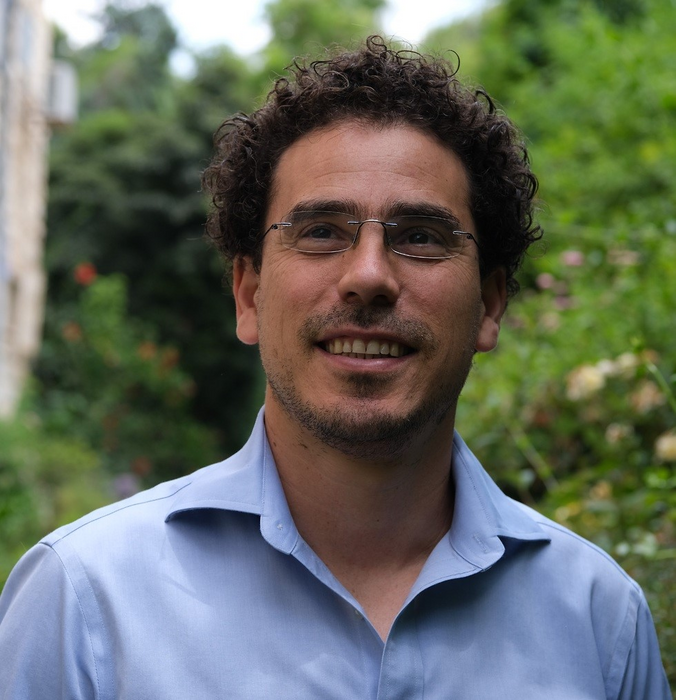If one wishes to use light efficiently, whether in photosynthesis or a photovoltaic system, it must be absorbed completely. This is more challenging if the absorption occurs in a thin layer of material that ordinarily allows a considerable portion of the light to flow through.
 HU Professor Ori Katz. Image Credit: Meital Covo
HU Professor Ori Katz. Image Credit: Meital Covo
Now, researchers from TU Wien and The Hebrew University of Jerusalem (HU) have discovered an unexpected method that permits a laser beam to be thoroughly absorbed even in the lightest of layers:
They used mirrors and lenses to create a “light trap” surrounding the thin layer, in which the light beam is guided in a circle and then overlaid on itself—exactly in such a way that the light beam stops itself and is unable to escape the system. As a result, there is no other option for the light except to be consumed by the thin layer.
This absorption-amplification method, which has now been published in the scientific journal Science, is the result of a productive partnership between the two teams: the strategy was recommended by Professor Ori Katz of The Hebrew University of Jerusalem and conceptualized with Professor Stefan Rotter of TU Wien.
The lab team performed the experiment in Jerusalem, and the theoretical results came from the Vienna team.
Absorbing light is easy when it hits a solid object. A thick black wool jumper can easily absorb light. But in many technical applications, you only have a thin layer of material available and you want the light to be absorbed exactly in this layer.
Stefan Rotter, Professor, Institute of Theoretical Physics, TU Wien
There have already been efforts to enhance material absorption, such as placing the material between two mirrors. The light is reflected back and forth between the two mirrors, traveling through the substance each time and therefore increasing the likelihood of absorption.
Nevertheless, for this function, one of the mirrors must be somewhat transparent—otherwise, light cannot enter the area between the two mirrors at all. However, when light strikes this partially transparent mirror, some of the light is dissipated.
It is possible to use light wave qualities in a sophisticated way to prevent this.
“In our approach, we can cancel all back-reflections by wave interference,” noted HU’s, Professor Ori Katz.
Helmut Hörner, from TU Wien, who devoted his thesis to this subject, explained, “In our method, too, the light first falls on a partially transparent mirror. If you simply send a laser beam onto this mirror, it is split into two parts: The larger part is reflected, a smaller part penetrates the mirror.”
After passing through the layer of absorbing material, the portion of the light beam that penetrated the mirror is transmitted back to the partially transparent mirror using lenses and another mirror.
“The crucial thing is that the length of this path and the position of the optical elements are adjusted in such a way that the returning light beam (and its multiple reflections between the mirrors) exactly cancels out the light beam reflected directly at the first mirror,” said Yevgeny Slobodkin and Gil Weinberg.
Yevgeny Slobodkin and Gil Weinberg were both graduate students at HU, who created the method in Jerusalem.
Even though the partially transparent mirror alone would represent a significant portion of the light, this reflection is made impossible by the additional part of the beam moving through the system before going back to the partially transparent mirror. This is known as a “light blocking” effect because of the way the two partial beams overlap.
As a result, the mirror, which was previously just partially transparent to the incident laser beam, is now entirely transparent. The light beam can enter the system, but it can no longer exit due to the superposition of the reflected component and the portion steered in a circle through the system.
As a result, the laser beam is entirely absorbed by a thin layer, which would have otherwise enabled most of the beam to pass through.
The system has to be tuned exactly to the wavelength you want to absorb.
Stefan Rotter, Professor, Institute of Theoretical Physics, TU Wien
“But apart from that, there are no limiting requirements. The laser beam doesn’t have to have a specific shape, it can be more intense in some places than in others—almost perfect absorption is always achieved.”
Experiments carried out at The Hebrew University in Jerusalem proved that the process is impervious to even air turbulence and temperature changes.
This demonstrates it as a reliable effect that offers a variety of potential uses; for instance, the proposed mechanism may be well adapted to precisely catching light signals that are warped during propagation through the Earth’s atmosphere.
The novel method may also be very helpful in the real world for directing light waves from weak light sources (like far-off stars) into a detector in the best possible way.
Journal Reference:
Slobodkin, Y., et al. (2022) Massively degenerate coherent perfect absorber for arbitrary wavefronts. Science. doi.org/10.1126/science.abq8103.